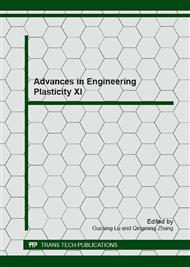p.314
p.318
p.322
p.326
p.330
p.334
p.338
p.342
p.346
The Effect of Interatomic Potentials on the Onset of Plasticity in the Molecular Dynamics (MD) Simulation of Nanometric Machining
Abstract:
The effect of interatomic potentials on the onset of plastic deformation in the nanometric machining of a crystalline diamond tool on a crystalline copper workpiece, was investigated by using the MD simulation. Three potential pairs were used for the copper-copper (workpiece) and the copper-carbon (tool-workpiece interface) atomic interactions. For case 1, the Morse potential was used for both the copper-copper and the copper-carbon interactions; for case 2, the Embedded Atom Method (EAM) potential was used for the copper-copper interactions and the Morse potential was used for the copper-carbon interactions; and for case 3, the EAM potential was used for the copper-copper interactions and the Lennard-Jones (LJ) potential was used for the copper-carbon interactions. The diamond tool was modelled as a deformable body and the Tersoff potential was applied for the carbon-carbon interactions. From the simulation results, pile-up volume and the force ratio appear to indicate the onset of plasticity during the machining. The pile-up volume shows that ploughing starts from 0.25nm, 0.20 and 0.30nm depth of cut for case 1, case 2 and case 3 respectively and the formation of chips starts to occur from the depth of cut of 1.5nm for case 3. The force ratio also indicate the onset of ploughing at different depths of cut from 0.10nm-0.3nm.
Info:
Periodical:
Pages:
330-333
Citation:
Online since:
January 2013
Authors:
Price:
Сopyright:
© 2013 Trans Tech Publications Ltd. All Rights Reserved
Share:
Citation:


